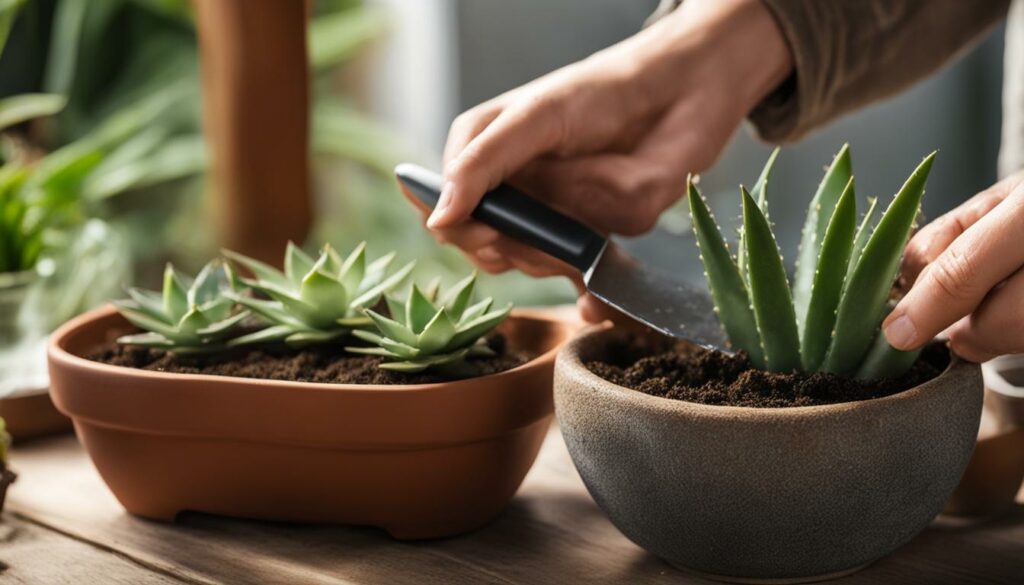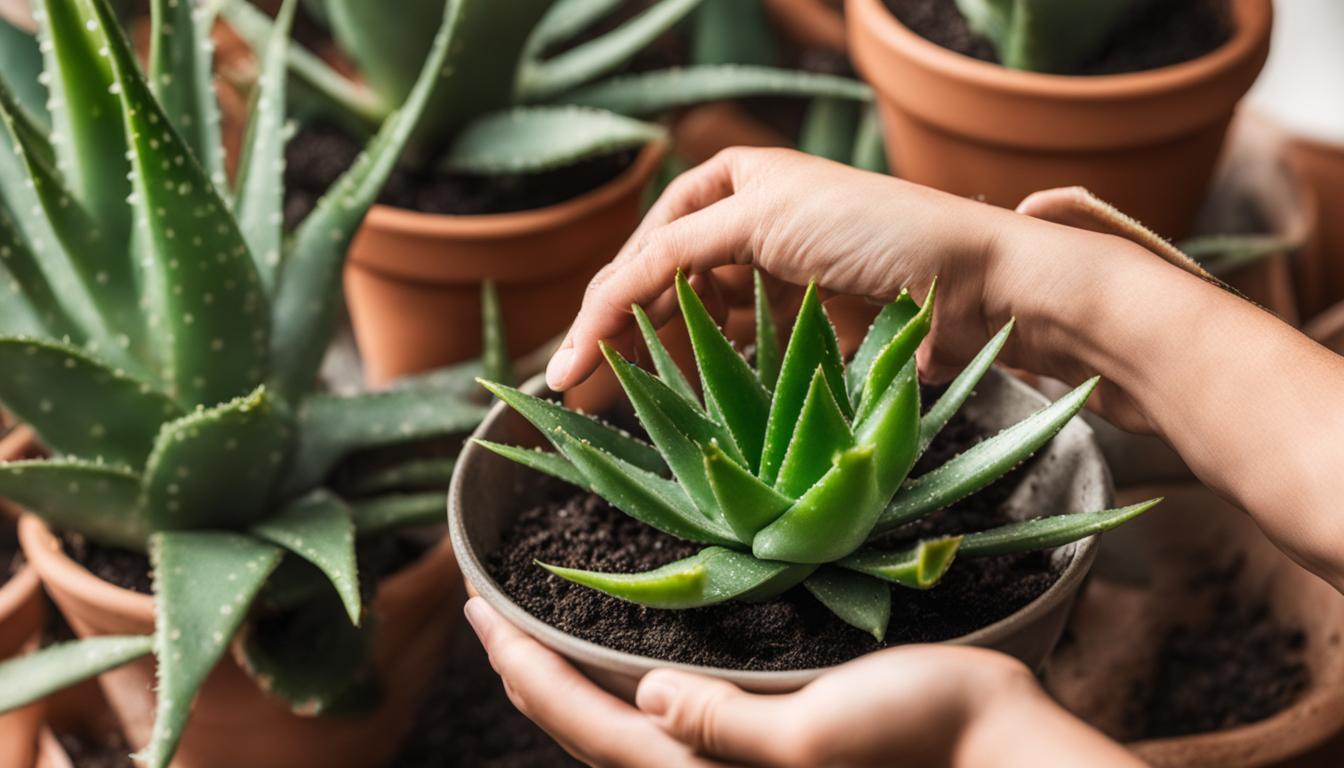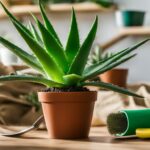Welcome to our comprehensive Star Aloe PlantCare Guide! Whether you’re a seasoned plant enthusiast or just starting your green journey, this guide will provide you with all the information you need to care for your Aloe Vera plants. Aloe vera is a succulent plant species known for its healing properties and stunning appearance. So, let’s dive in and discover the secrets to keeping your Aloe plants thriving and happy!
When it comes to Aloe plant care, there are a few key factors to keep in mind. From choosing the right container and potting mix to understanding proper lighting, watering, and fertilizing techniques, we’ve got you covered. Whether you’re a proud owner of a single Aloe vera plant or have a collection of these botanical beauties, this guide will take your plant care skills to the next level.
About Aloe Vera Plants
Aloe vera plants are unique succulent plants known for their fleshy leaves and numerous health benefits. These plants are native to arid regions and have adapted to survive in hot, dry climates. Aloe vera plants have stemless or short stems, with thick, greenish leaves that fan out from the central stem. The leaves are fleshy and contain a gel-like substance that is rich in vitamins, minerals, and antioxidants.
Aloe vera plants are prized for their medicinal properties and have been used for centuries in traditional medicine. The gel from the leaves of the plant is commonly used topically to soothe and heal skin conditions such as burns, sunburns, and wounds. It is also believed to have anti-inflammatory, antimicrobial, and antioxidant effects.
In addition to their medicinal uses, aloe vera plants are also popular as ornamental plants. Their unique appearance and minimal care requirements make them a favorite among plant enthusiasts. Aloe vera plants can add a touch of greenery to any indoor or outdoor space, and they are relatively easy to grow and maintain.
The Benefits of Aloe Vera Plants
Aloe vera plants offer a range of benefits, making them a valuable addition to any garden or home decor. Here are some of the key benefits of having an aloe vera plant:
- • Air purification: Aloe vera plants help remove harmful toxins from the air, improving indoor air quality.
- • Natural first aid: The gel from aloe vera leaves can be used to treat minor burns, cuts, and insect bites.
- • Beauty care: Aloe vera gel is a common ingredient in skincare products, thanks to its moisturizing and soothing properties.
- • Low maintenance: Aloe vera plants are relatively low maintenance and can tolerate a wide range of growing conditions.
Whether you’re looking to enhance your indoor space or reap the health benefits of aloe vera, investing in an aloe vera plant is a worthwhile choice.
Aloe Vera Planting: Tips for Success
When it comes to planting Aloe vera, there are a few key factors to consider in order to ensure the success and health of your plant. Choosing the right container is crucial, as Aloe vera requires a well-draining potting mix and proper drainage. Opt for a container with at least one drainage hole in the bottom to prevent water from accumulating and causing root rot. Additionally, using a potting mix specifically designed for succulents and cacti will provide the ideal environment for your Aloe vera plant to thrive.

When planting your Aloe vera, it’s recommended to dust the stem of the plant with a rooting hormone powder. This will help stimulate the growth of new roots, ensuring that your plant establishes itself firmly in its new container. Once you’ve prepared the container and added the potting mix, gently place the Aloe vera plant in the center, making sure the roots are covered with soil. Avoid burying the stem too deeply, as this can lead to rotting.
Table: Aloe Vera Planting Checklist
| Container | Potting Mix | Rooting Hormone |
|---|---|---|
| Choose a container with drainage holes | Use a well-draining potting mix for succulents and cacti | Dust the stem with rooting hormone powder |
| Ensure the container is the right size for the plant | Do not use regular garden soil | Rooting hormone stimulates root growth |
| Place the container in a location with adequate sunlight | Avoid heavy or clay-based soils | Apply rooting hormone powder to the stem before planting |
Once you’ve planted your Aloe vera, it’s important to place it in a location with adequate sunlight. Aloe vera plants thrive in bright, indirect light, so choose a spot near a window or provide artificial light if necessary. In terms of watering, Aloe vera plants prefer to be watered deeply but infrequently. Allow the soil to dry out between waterings to prevent overwatering, which can lead to root rot.
By following these planting tips, you can ensure that your Aloe vera plant has the best chance of thriving and staying healthy. Remember to choose the right container and potting mix, use rooting hormone powder, and provide adequate sunlight and proper watering. With proper care, your Aloe vera plant will reward you with its beauty and potential medicinal benefits.
How to Care for Aloe Vera Plants
Proper care is essential for the growth and well-being of your Aloe vera plants. This section will provide you with all the information you need to ensure your plants thrive.
Lighting
Aloe vera plants require bright, indirect sunlight or artificial light to thrive. Place your plants in a location where they can receive at least six hours of bright, indirect sunlight each day. If placing them indoors, near a south or west-facing window is ideal. If artificial light is used, a fluorescent light setup with a mix of cool and warm white bulbs can provide sufficient light.
Temperature
Aloe vera plants prefer temperatures between 55 and 80°F (13-27°C). They can tolerate slightly lower temperatures for short periods but may experience damage if exposed to frost or extreme cold. It is important to keep your plants away from drafty areas and ensure they are not subjected to temperature fluctuations, as this can stress the plant.
Watering
When it comes to watering your Aloe vera plants, it’s crucial to strike a balance. These plants are succulents and are adapted to arid conditions, so they don’t require frequent watering. Allow the soil to dry out between waterings to prevent overwatering, which can lead to root rot. When watering, thoroughly soak the soil and allow any excess water to drain away.
Fertilizing
Aloe vera plants are relatively low-maintenance when it comes to fertilizing. They can be fed with a balanced houseplant fertilizer once a month during the spring and summer months. It’s important not to over-fertilize, as this can lead to the accumulation of salts in the soil, which can harm the plant. Always follow the instructions on the fertilizer packaging and dilute it to half strength for Aloe vera plants.
By following these care guidelines, you can ensure that your Aloe vera plants thrive and remain healthy. Remember to provide them with adequate lighting, monitor the temperature, water sparingly, and fertilize in moderation. With the right care, you can enjoy the beauty and benefits of these versatile plants.
Aloe Vera Plant Propagation
Propagating Aloe vera plants is a simple and rewarding process that allows you to expand your collection or share the beauty of this versatile plant with others. Aloe vera plants often produce offsets, also known as pups, which can be easily separated from the mother plant and grown into new plants.
To propagate Aloe vera, start by identifying healthy, mature offsets that have developed their own root system. Gently remove the offset from the mother plant, ensuring that you also have some of its roots intact. A clean, sharp knife or gardening shears can be used for this purpose. It is essential to handle the plant with care to avoid damaging the roots or causing unnecessary stress.
Once you have removed the offset, allow it to callous over for a few days. This process helps to prevent rotting when the plant is placed in soil. After the callousing period, the offset can be potted in a well-draining succulent potting mix. Place the pot in a warm location with indirect light, as direct sunlight can scorch the young plant. Water sparingly, allowing the soil to dry out between waterings.
| Propagation Method | Description |
|---|---|
| Offsets | These are small plants that grow from the base of the mother plant. They can be separated and potted individually. |
| Leaf Cuttings | Leaves from a mature plant can be cut and allowed to callous before being placed in soil to grow new plants. |
| Seeds | Aloe vera seeds can be collected and germinated to grow new plants, but this method requires patience and time. |
“Propagating Aloe vera plants is not only a great way to expand your green collection but also a means of sharing the benefits of this remarkable plant with others. It’s truly rewarding to watch your propagated babies grow into mature, thriving plants.”
With a little patience and care, you can successfully propagate Aloe vera plants and enjoy the beauty and benefits of these wonderful succulents. Whether you choose to propagate through offsets, leaf cuttings, or seeds, remember to provide them with the right conditions and monitor their growth. Soon enough, you’ll have a flourishing collection of Aloe vera plants to brighten up your space.
Aloe Vera Plant Common Issues

While Aloe vera plants are generally easy to care for, they can be prone to a few common issues. It’s important to identify and address these problems promptly to ensure the health and longevity of your plant.
Pests
One common issue that aloe vera plants may encounter is an infestation of pests such as aphids and mealybugs. These small insects feed on the sap of the plant and can cause damage if left untreated. To combat these pests, you can use insecticidal soap or neem oil. Apply the solution to the affected areas of the plant, making sure to thoroughly cover all surfaces. Repeat the treatment as necessary until the pests are eliminated.
Pruning
Pruning is an essential part of caring for aloe vera plants. Regular pruning helps to remove dry or dead leaves and encourages new growth. When pruning, use a clean, sharp pair of pruning shears to make clean cuts close to the base of the plant. Be cautious not to cut too close to the stem, as this can cause damage. Pruning should be done with care and moderation, ensuring that you do not remove too many leaves at once.
Preventing Root Rot
Overwatering can lead to root rot, which is a common issue in aloe vera plants. To prevent root rot, it’s important to provide proper drainage for your plant. Choose a well-draining potting mix and a pot with drainage holes to allow excess water to escape. Additionally, make sure to water your plant only when the top inch of soil feels dry to the touch. Water deeply but infrequently, allowing the soil to dry out between waterings. By monitoring your plant’s watering needs and providing proper drainage, you can help prevent root rot and keep your aloe vera plant healthy.
| Common Issues | Solutions |
|---|---|
| Pests (aphids, mealybugs) | Use insecticidal soap or neem oil to treat infestations. Apply the solution to the affected areas of the plant. |
| Pruning | Regularly prune to remove dry or dead leaves and encourage new growth. Use clean, sharp pruning shears. |
| Preventing Root Rot | Ensure proper drainage by using a well-draining potting mix and a pot with drainage holes. Water deeply but infrequently, allowing the soil to dry out between waterings. |
Aloe Vera Plant Harvesting and Flowering
Harvesting aloe vera plants is a simple process that allows you to harness the many benefits of this versatile plant. To harvest, simply slice off mature leaves as close to the base as possible. It’s important to allow the base of the leaf to callous before use, as this helps retain the gel’s healing properties. The gel can be used topically to soothe sunburns, moisturize the skin, or treat minor cuts and scrapes. It can also be consumed as a juice or added to smoothies for its potential internal health benefits.
“Aloe vera plants can produce tall flower spikes with tubular yellow or red blossoms.”
While aloe vera plants are primarily grown for their gel, they can also produce beautiful flowering spikes under the right conditions. The flowers are tubular in shape and come in shades of yellow or red. However, it’s important to note that indoor conditions are usually not ideal for aloe vera plants to flower. If you are lucky enough to see your aloe vera plant produce flowers, it is a sign that your plant is happy and healthy. Enjoy the beauty of the blossoms, but remember that the primary focus is on the plant’s gel and its health benefits.
Growing Aloe Vera for Maximum Gel Production
If you’re primarily interested in harvesting aloe vera gel, there are a few steps you can take to promote maximum gel production. Make sure your aloe vera plant receives plenty of sunlight, as this helps stimulate the gel-forming cells in the leaves. Aloe vera plants also require well-draining soil, as waterlogged roots can inhibit gel production. Additionally, avoid overwatering and allow the soil to dry out between waterings. By providing optimal growing conditions and regular care, you can have a thriving aloe vera plant that provides an abundant supply of gel for all your needs.
Conclusion
Now that you have learned how to care for your Star Aloe plant, it’s time to put that knowledge into action. Remember to provide your Aloe vera with the right amount of light, maintaining a temperature range of 55 to 80°F, and watering it deeply but infrequently. Don’t forget to use a well-draining potting mix and avoid overwatering to prevent root rot.
If your Aloe vera plant produces offsets or pups, take the opportunity to propagate and create new plants. Simply remove the offsets, let them callous over, and plant them in a succulent potting mix. With proper care, these new plants will thrive alongside their parent plant.
Keep an eye out for common issues like aphids and mealybugs, and treat them promptly with insecticidal soap or neem oil. Pruning can also help remove dry leaves and encourage new growth. By following these care tips and paying attention to your Aloe vera’s health, you can enjoy the benefits of this versatile and beautiful plant for years to come.
FAQ
What is aloe vera?
Aloe vera is a succulent plant species known for its thick, fleshy leaves and medicinal properties.
Can I eat the gel from aloe vera leaves?
No, the gel from aloe vera leaves should not be eaten as it can cause unpleasant symptoms and may be toxic in larger quantities.
What kind of container should I use for planting aloe vera?
It is important to choose a container with proper drainage. Use a well-draining potting mix made for succulents and cacti.
How much light do aloe vera plants need?
Aloe vera plants thrive in bright, indirect sunlight or artificial light.
How often should I water my aloe vera plant?
Water deeply but infrequently, allowing the soil to dry out between waterings.
How often should I fertilize my aloe vera plant?
Aloe vera plants do not require frequent fertilizing. Use a balanced houseplant formula once a month during the spring and summer.
How do I propagate aloe vera plants?
Aloe vera plants produce offsets or pups that can be separated from the mother plant and planted in a well-draining succulent potting mix.
What should I do if my aloe vera plant has pests?
Treat aphids and mealybugs with insecticidal soap or neem oil. Prune dry, dead leaves to encourage new growth.
How can I harvest aloe vera plants?
Mature leaves can be sliced off and the gel can be used for various purposes. Allow the base of the leaf to callous before using it.
Can aloe vera plants flower indoors?
Aloe vera plants can produce tall flower spikes with tubular yellow or red blossoms, but indoor conditions are usually not ideal for flowering.





